Wolfgang Liebeneiner (1905-1987) was a German-Austrian film and stage actor, who turned into a successful director in the mid-1930s. Under the Nazi regime, he had a thriving career. He directed a few propaganda films and had important positions at the Reichsfilmkammer and the Ufa. After the war, he could continue his career smoothly in both the theatre and the cinema.

German postcard by Ross Verlag, no. 7606/1, 1932-1933. Photo: Elite-Tonfilm. Wolfgang Liebeneiner in Liebelei/Flirtation (Max Ophüls, 1933).

German postcard by Ross Verlag, no. 8287/1, 1941-1944. Photo: Walther Jaeger, Berlin.

German postcard by Ross Verlag, no. 8398/1, 1933-1934. Photo: Walther Jaeger, Berlin.

German postcard by Ross Verlag, no. 8838/1, 1933-1934. Photo: Boston-Film. Wolfgang Liebeneiner in Abschiedswalzer/Farewell Waltz (Géza von Bolváry, 1934).
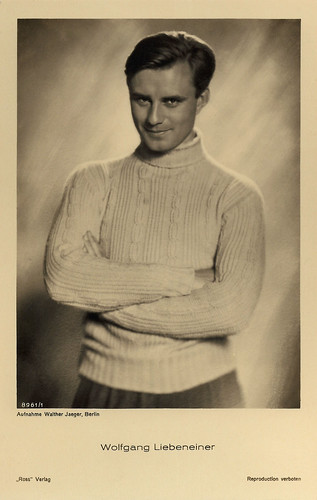
German postcard by Ross Verlag, no. 8961/1, 1933-1934. Photo: Walther Jaeger.
Wolfgang Georg Louis Liebeneiner was born in Liebau in Prussian Silesia Germany (now Lubomierz, Poland) in 1905. He was the son of a textile manufacturer.
Wolfgang was sent to the cadet schools Wahlstatt und Berlin-Lichterfelde and went for further schooling in Berlin-Zehlendorf. After graduating, he studied philosophy, Germanistik, and international history in Innsbruck (Austria), Berlin, and Munich. During his studies, he became the head of an academic stage group in Munich.
In 1928, he studied acting and directing with Otto Falckenberg, the director of the Munich Kammerspiele. That same year he debuted in Frank Wedekind's 'Frühlings Erwachen' (Spring Awakening) and from then on he devoted himself entirely to acting.
In 1931 he made his debut as a theatre director and that year he also made his first film appearance as a British lieutenant in the World War I drama Die andere Seite/The Other Side (Heinz Paul, 1931), based on the play Journey’s End by R.C. Sherriff. Conrad Veidt and Theodor Loos were the stars, and Liebeneiner played a supporting part.
Soon followed more films, such as the romantic drama Liebelei/Flirtation (Max Ophüls, 1933) with Magda Schneider, the comedy Die schönen Tage von Aranjuez/The Good Old Days of Aranjuez (Johannes Meyer, 1933) starring Brigitte Helm, and the biopic Abschiedswalzer/Farewell Waltz (Géza von Bolváry, 1934), in which he starred as composer Frédéric Chopin. In these films he often played subtle, tragic lovers, both in supporting as well as leading roles. In 1936, Liebeneiner became a member of the Preußisches Staatstheater Berlin (Prussian State Theater of Berlin).

German postcard by Ross Verlag, no. 9104/1, 1935-1936. Photo: Atelier Binder, Berlin.
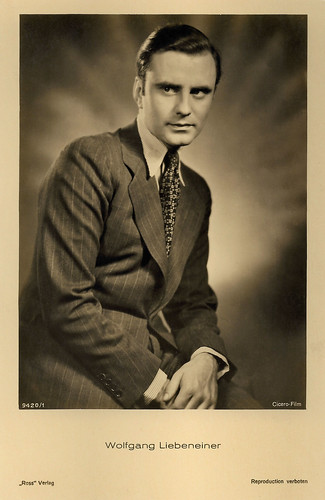
German postcard by Ross Verlag, no. 9420/1, 1935-1936. Photo: Cicero Film. Publicity still for Eine Nacht an der Donau/A Night on the Danube (Carl Boese, 1935).
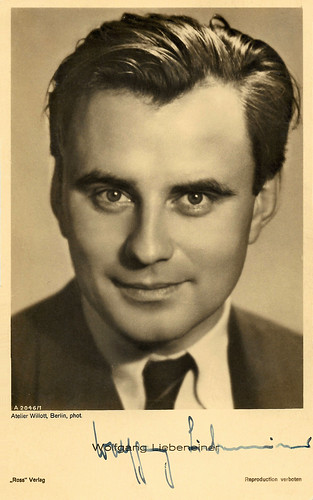
German postcard by Ross Verlag, no. A 2046/1, 1939-1940. Photo: Atelier Willott, Berlin.

German postcard by Ross Verlag, no. A 3060/1, 1941-1944. Photo: Willott.

Austrian postcard by Verlag Hubmann (HDH Verlag), Wien, no. 90. Photo: Constantin-Film. Hans Söhnker in Die Stärkere/The stronger (Wolfgang Liebeneiner, 1953).
In 1937, Wolfgang Liebeneiner directed his first film, Versprich mir nichts!/Promise Me Nothing (Wolfgang Liebeneiner, 1937) with Luise Ullrich. It was soon followed by the Heinz Rühmann comedy Der Mustergatte/Model Husband (Wolfgang Liebeneiner, 1937).
Liebeneiner’s career thrived in Nazi Germany. In the following years, he directed a dozen films, including hits as Du und ich/You and I (1938) with Brigitte Horney, the comedy Der Florentiner Hut/The Leghorn Hat (1939), and Bismarck (1940), a biographical film about Otto von Bismarck, the Prime Minister of Prussia, which focuses how he and his aggressive war policies helped to unite Germany.
Liebeneiner was appointed artistic director of the Deutsche Filmakademie Babelsberg (German Film Academy Babelsberg) in 1938 and a year later he became head of the Fachschaft Film of the Reichsfilmkammer. This was a department of the Chamber of Film, to which all actors, directors, and other filmmakers had to accede to further pursue their professional activities in Nazi Germany. This department was responsible for the Berufsverbote for Jews and left-wingers. About 3000 film workers were excluded by the Reichsfilmkammer).
In 1941, he directed the film Ich klage an/I Accuse (Wolfgang Liebeneiner, 1941) in cooperation with the National Socialist Ministry of Propaganda. The film was about the voluntary Euthanasia of a woman suffering from multiple sclerosis but was intended to support the T-4 Euthanasia Program. Over 70,000 men, women, and children were killed as a result of this program.
His next film, Die Entlassung/Bismarck's Dismissal (Wolfgang Liebeneiner, 1942) focused once again on Bismarck, played by Emil Jannings. From 1942 to 1945 Liebeneiner became the production chief at the Ufa (Universum Film AG), the largest German film studio at that time. In 1943, Propaganda Minister Josef Goebbels even appointed him a professor.

German postcard by Kunst und Bild, Berlin, no. A 798. Photo: Capitol Film / Prisma / Arthur Grimm. Gertrud Kückelmann in Die Stärkere/The Stronger (Wolfgang Liebeneiner, 1953).

German collectors card by Helmstedter Margarinewerk GMBH, Helmstedt. Photo: Capitol / Prisma / Grimm. Antje Weisgerber in Die Stärkere/The stronger ones (Wolfgang Liebeneiner, 1953). Gift by Didier Hanson.

German postcard by Kolibri-Verlag, no. 1293. Photo: Algefa / Constantin / Wesel. Waltraut Haas and Fritz Wagner in Die Schöne Müllerin/The beautiful Miller (Wolfgang Liebeneiner, 1954).

West-German postcard by Kunst und Bild, Berlin, no. A 1221. Photo: Algefa / Constantin / Wesel. Katharina Mayberg in Die schöne Müllerin/The Beautiful Miller (Wolfgang Liebeneiner, 1954).
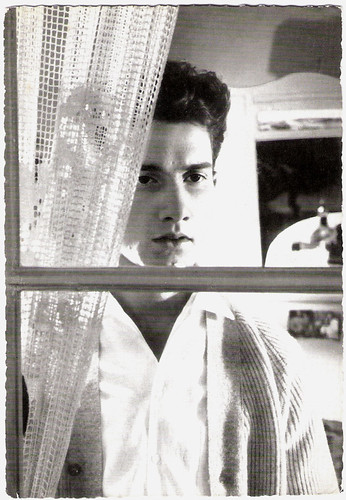
German postcard by WS-Druck, Wanne-Eickel, no. 339. Photo: Bavaria. Christian Wolff in Immer wenn der Tag beginnt/Always when the Day starts (Wolfgang Liebeneiner, 1957).
After the war, Wolfgang Liebeneiner could soon resume his theatre career. Already in the autumn of 1945, he was directing again. In 1947, he directed the premiere of Wolfgang Borchert's play 'Draußen vor der Tür' (The Man Outside) at the Hamburger Kammerspiele. He also directed the film version, Liebe 47/Love ‘47 (Wolfgang Liebeneiner, 1949) with his second wife, Hilde Krahl. From then he directed two to three light entertainment films a year.
In the Adenauer era, Liebeneiner directed romantic dramas in which Ruth Leuwerik repeatedly played the lead role, such as Die Trapp-Familie/The Trapp Family (Wolfgang Liebeneine, 1956r) with Hans Holt, and Königin Luise/Queen Louise (Wolfgang Liebeneiner, 1957) with Dieter Borsche. These films were all very successful in German-speaking countries, and Liebeneiner also played bit parts in some of them.
In the 1960s, he turned more and more to television, for which he filmed mainly plays, novels, and short stories. Incidentally, he made a film, for instance, Schwejks Flegeljahre/Schweik's Years of Indiscretion (Wolfgang Liebeneiner, 1965) with Peter Alexander in the role of soldier Josef Schwejk. In 1966 he directed the mini-series Die Schatzinsel/Treasure Island, based on Robert Louis Stevenson's novel.
In 1977 he made one final feature film, Das chinesische Wunder/The Chinese Wonder (Wolfgang Liebeneiner, 1977) starring Senta Berger and Heinz Rühmann. J. Steed reviews at IMDb: “This is a dreadful and almost unbearable drama (…) Not only the subject of the badly written script is boring, Liebeneiner directs with disinterest.” Liebeneiner continued to make TV films till 1984. Meanwhile, in the theatre, he focused particularly on the staging of operas and operettas at various opera houses.
After a long illness, Wolfgang Liebeneiner died in 1987 in Mödling near Vienna, Austria. He had been married twice: first, in 1934 to actress Ruth Hellberg. This marriage ended in a divorce. In 1944 he married the actress Hilde Krahl, whom he had met during the filming of Yvette, and who starred in several of his films. They had two daughters, of which Johanna Liebeneiner also became an actress.

German postcard by Kolibri-Verlag, no. 1447. Photo: Berolina / Constantin-Film / Wesel. Ulla Jacobsson and Karlheinz Böhm in Die heilige Lüge/Sacred Lie (Wolfgang Liebeneiner, 1954).

German postcard by Kunst und Bild, Berlin, no. A 1367. Photo: Berolina / Constantin / Wesel. Franca Parisi in Die heilige Lüge/Sacred Lie (Wolfgang Liebeneiner, 1954).

German postcard by Franz Josef Rüdel, Filmpostkartenverlag, Hamburg-Bergedorf, no. FT 33. Photo: CCC / Gloria / Grimm. Ruth Leuwerik in Auf Wiedersehen, Franziska!/Goodbye, Franziska! (Wolfgang Liebeneiner, 1957).
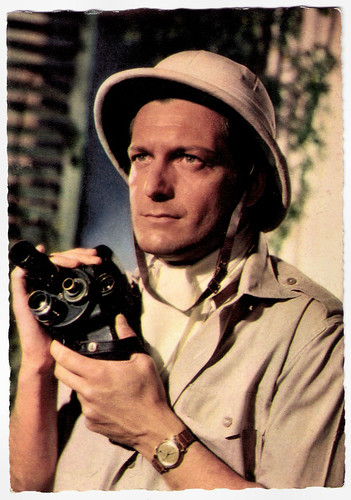
German postcard by Franz Josef Rüdel, Filmpostkartenverlag, Hamburg-Bergedorf, no. FT 20. Photo: CCC / Gloria-Film / Grimm. Carlos Thompson in Franziska (Wolfgang Liebeneiner, 1957).

German postcard by Ufa/Film-Foto, Berlin-Tempelhof, no. FK 4662. Retail price: 25 Pfg. Photo: Lars Looschen / Ufa. Walter Reyer in Jacqueline (Wolfgang Liebeneiner, 1959).

German postcard by Rüdel-Verlag, Hamburg-Bergedorf, no. 2967. Photo: Öfa / Deutsche Film Hansa / Appelt. Hannelore Auer in Ich heirate Herrn Direktor/I'm Getting Married Mr Director (Wolfgang Liebeneiner, 1960).
Scene from Die Trapp Familie in Amerika (1958) with Ruth Leuwerik and Hans Holt. Source: Melanie Zander (YouTube).
Sources: Rudi Polt (IMDb), J. Steed (IMDb), Wikipedia (German and English), and IMDb.
This post was last updated on 21 March 2025.

German postcard by Ross Verlag, no. 7606/1, 1932-1933. Photo: Elite-Tonfilm. Wolfgang Liebeneiner in Liebelei/Flirtation (Max Ophüls, 1933).

German postcard by Ross Verlag, no. 8287/1, 1941-1944. Photo: Walther Jaeger, Berlin.

German postcard by Ross Verlag, no. 8398/1, 1933-1934. Photo: Walther Jaeger, Berlin.

German postcard by Ross Verlag, no. 8838/1, 1933-1934. Photo: Boston-Film. Wolfgang Liebeneiner in Abschiedswalzer/Farewell Waltz (Géza von Bolváry, 1934).

German postcard by Ross Verlag, no. 8961/1, 1933-1934. Photo: Walther Jaeger.
Subtle, tragic lovers
Wolfgang Georg Louis Liebeneiner was born in Liebau in Prussian Silesia Germany (now Lubomierz, Poland) in 1905. He was the son of a textile manufacturer.
Wolfgang was sent to the cadet schools Wahlstatt und Berlin-Lichterfelde and went for further schooling in Berlin-Zehlendorf. After graduating, he studied philosophy, Germanistik, and international history in Innsbruck (Austria), Berlin, and Munich. During his studies, he became the head of an academic stage group in Munich.
In 1928, he studied acting and directing with Otto Falckenberg, the director of the Munich Kammerspiele. That same year he debuted in Frank Wedekind's 'Frühlings Erwachen' (Spring Awakening) and from then on he devoted himself entirely to acting.
In 1931 he made his debut as a theatre director and that year he also made his first film appearance as a British lieutenant in the World War I drama Die andere Seite/The Other Side (Heinz Paul, 1931), based on the play Journey’s End by R.C. Sherriff. Conrad Veidt and Theodor Loos were the stars, and Liebeneiner played a supporting part.
Soon followed more films, such as the romantic drama Liebelei/Flirtation (Max Ophüls, 1933) with Magda Schneider, the comedy Die schönen Tage von Aranjuez/The Good Old Days of Aranjuez (Johannes Meyer, 1933) starring Brigitte Helm, and the biopic Abschiedswalzer/Farewell Waltz (Géza von Bolváry, 1934), in which he starred as composer Frédéric Chopin. In these films he often played subtle, tragic lovers, both in supporting as well as leading roles. In 1936, Liebeneiner became a member of the Preußisches Staatstheater Berlin (Prussian State Theater of Berlin).

German postcard by Ross Verlag, no. 9104/1, 1935-1936. Photo: Atelier Binder, Berlin.

German postcard by Ross Verlag, no. 9420/1, 1935-1936. Photo: Cicero Film. Publicity still for Eine Nacht an der Donau/A Night on the Danube (Carl Boese, 1935).

German postcard by Ross Verlag, no. A 2046/1, 1939-1940. Photo: Atelier Willott, Berlin.

German postcard by Ross Verlag, no. A 3060/1, 1941-1944. Photo: Willott.

Austrian postcard by Verlag Hubmann (HDH Verlag), Wien, no. 90. Photo: Constantin-Film. Hans Söhnker in Die Stärkere/The stronger (Wolfgang Liebeneiner, 1953).
Aggressive war policies
In 1937, Wolfgang Liebeneiner directed his first film, Versprich mir nichts!/Promise Me Nothing (Wolfgang Liebeneiner, 1937) with Luise Ullrich. It was soon followed by the Heinz Rühmann comedy Der Mustergatte/Model Husband (Wolfgang Liebeneiner, 1937).
Liebeneiner’s career thrived in Nazi Germany. In the following years, he directed a dozen films, including hits as Du und ich/You and I (1938) with Brigitte Horney, the comedy Der Florentiner Hut/The Leghorn Hat (1939), and Bismarck (1940), a biographical film about Otto von Bismarck, the Prime Minister of Prussia, which focuses how he and his aggressive war policies helped to unite Germany.
Liebeneiner was appointed artistic director of the Deutsche Filmakademie Babelsberg (German Film Academy Babelsberg) in 1938 and a year later he became head of the Fachschaft Film of the Reichsfilmkammer. This was a department of the Chamber of Film, to which all actors, directors, and other filmmakers had to accede to further pursue their professional activities in Nazi Germany. This department was responsible for the Berufsverbote for Jews and left-wingers. About 3000 film workers were excluded by the Reichsfilmkammer).
In 1941, he directed the film Ich klage an/I Accuse (Wolfgang Liebeneiner, 1941) in cooperation with the National Socialist Ministry of Propaganda. The film was about the voluntary Euthanasia of a woman suffering from multiple sclerosis but was intended to support the T-4 Euthanasia Program. Over 70,000 men, women, and children were killed as a result of this program.
His next film, Die Entlassung/Bismarck's Dismissal (Wolfgang Liebeneiner, 1942) focused once again on Bismarck, played by Emil Jannings. From 1942 to 1945 Liebeneiner became the production chief at the Ufa (Universum Film AG), the largest German film studio at that time. In 1943, Propaganda Minister Josef Goebbels even appointed him a professor.

German postcard by Kunst und Bild, Berlin, no. A 798. Photo: Capitol Film / Prisma / Arthur Grimm. Gertrud Kückelmann in Die Stärkere/The Stronger (Wolfgang Liebeneiner, 1953).

German collectors card by Helmstedter Margarinewerk GMBH, Helmstedt. Photo: Capitol / Prisma / Grimm. Antje Weisgerber in Die Stärkere/The stronger ones (Wolfgang Liebeneiner, 1953). Gift by Didier Hanson.

German postcard by Kolibri-Verlag, no. 1293. Photo: Algefa / Constantin / Wesel. Waltraut Haas and Fritz Wagner in Die Schöne Müllerin/The beautiful Miller (Wolfgang Liebeneiner, 1954).

West-German postcard by Kunst und Bild, Berlin, no. A 1221. Photo: Algefa / Constantin / Wesel. Katharina Mayberg in Die schöne Müllerin/The Beautiful Miller (Wolfgang Liebeneiner, 1954).

German postcard by WS-Druck, Wanne-Eickel, no. 339. Photo: Bavaria. Christian Wolff in Immer wenn der Tag beginnt/Always when the Day starts (Wolfgang Liebeneiner, 1957).
The Adenauer era
After the war, Wolfgang Liebeneiner could soon resume his theatre career. Already in the autumn of 1945, he was directing again. In 1947, he directed the premiere of Wolfgang Borchert's play 'Draußen vor der Tür' (The Man Outside) at the Hamburger Kammerspiele. He also directed the film version, Liebe 47/Love ‘47 (Wolfgang Liebeneiner, 1949) with his second wife, Hilde Krahl. From then he directed two to three light entertainment films a year.
In the Adenauer era, Liebeneiner directed romantic dramas in which Ruth Leuwerik repeatedly played the lead role, such as Die Trapp-Familie/The Trapp Family (Wolfgang Liebeneine, 1956r) with Hans Holt, and Königin Luise/Queen Louise (Wolfgang Liebeneiner, 1957) with Dieter Borsche. These films were all very successful in German-speaking countries, and Liebeneiner also played bit parts in some of them.
In the 1960s, he turned more and more to television, for which he filmed mainly plays, novels, and short stories. Incidentally, he made a film, for instance, Schwejks Flegeljahre/Schweik's Years of Indiscretion (Wolfgang Liebeneiner, 1965) with Peter Alexander in the role of soldier Josef Schwejk. In 1966 he directed the mini-series Die Schatzinsel/Treasure Island, based on Robert Louis Stevenson's novel.
In 1977 he made one final feature film, Das chinesische Wunder/The Chinese Wonder (Wolfgang Liebeneiner, 1977) starring Senta Berger and Heinz Rühmann. J. Steed reviews at IMDb: “This is a dreadful and almost unbearable drama (…) Not only the subject of the badly written script is boring, Liebeneiner directs with disinterest.” Liebeneiner continued to make TV films till 1984. Meanwhile, in the theatre, he focused particularly on the staging of operas and operettas at various opera houses.
After a long illness, Wolfgang Liebeneiner died in 1987 in Mödling near Vienna, Austria. He had been married twice: first, in 1934 to actress Ruth Hellberg. This marriage ended in a divorce. In 1944 he married the actress Hilde Krahl, whom he had met during the filming of Yvette, and who starred in several of his films. They had two daughters, of which Johanna Liebeneiner also became an actress.

German postcard by Kolibri-Verlag, no. 1447. Photo: Berolina / Constantin-Film / Wesel. Ulla Jacobsson and Karlheinz Böhm in Die heilige Lüge/Sacred Lie (Wolfgang Liebeneiner, 1954).

German postcard by Kunst und Bild, Berlin, no. A 1367. Photo: Berolina / Constantin / Wesel. Franca Parisi in Die heilige Lüge/Sacred Lie (Wolfgang Liebeneiner, 1954).

German postcard by Franz Josef Rüdel, Filmpostkartenverlag, Hamburg-Bergedorf, no. FT 33. Photo: CCC / Gloria / Grimm. Ruth Leuwerik in Auf Wiedersehen, Franziska!/Goodbye, Franziska! (Wolfgang Liebeneiner, 1957).

German postcard by Franz Josef Rüdel, Filmpostkartenverlag, Hamburg-Bergedorf, no. FT 20. Photo: CCC / Gloria-Film / Grimm. Carlos Thompson in Franziska (Wolfgang Liebeneiner, 1957).

German postcard by Ufa/Film-Foto, Berlin-Tempelhof, no. FK 4662. Retail price: 25 Pfg. Photo: Lars Looschen / Ufa. Walter Reyer in Jacqueline (Wolfgang Liebeneiner, 1959).

German postcard by Rüdel-Verlag, Hamburg-Bergedorf, no. 2967. Photo: Öfa / Deutsche Film Hansa / Appelt. Hannelore Auer in Ich heirate Herrn Direktor/I'm Getting Married Mr Director (Wolfgang Liebeneiner, 1960).
Scene from Die Trapp Familie in Amerika (1958) with Ruth Leuwerik and Hans Holt. Source: Melanie Zander (YouTube).
Sources: Rudi Polt (IMDb), J. Steed (IMDb), Wikipedia (German and English), and IMDb.
This post was last updated on 21 March 2025.
No comments:
Post a Comment